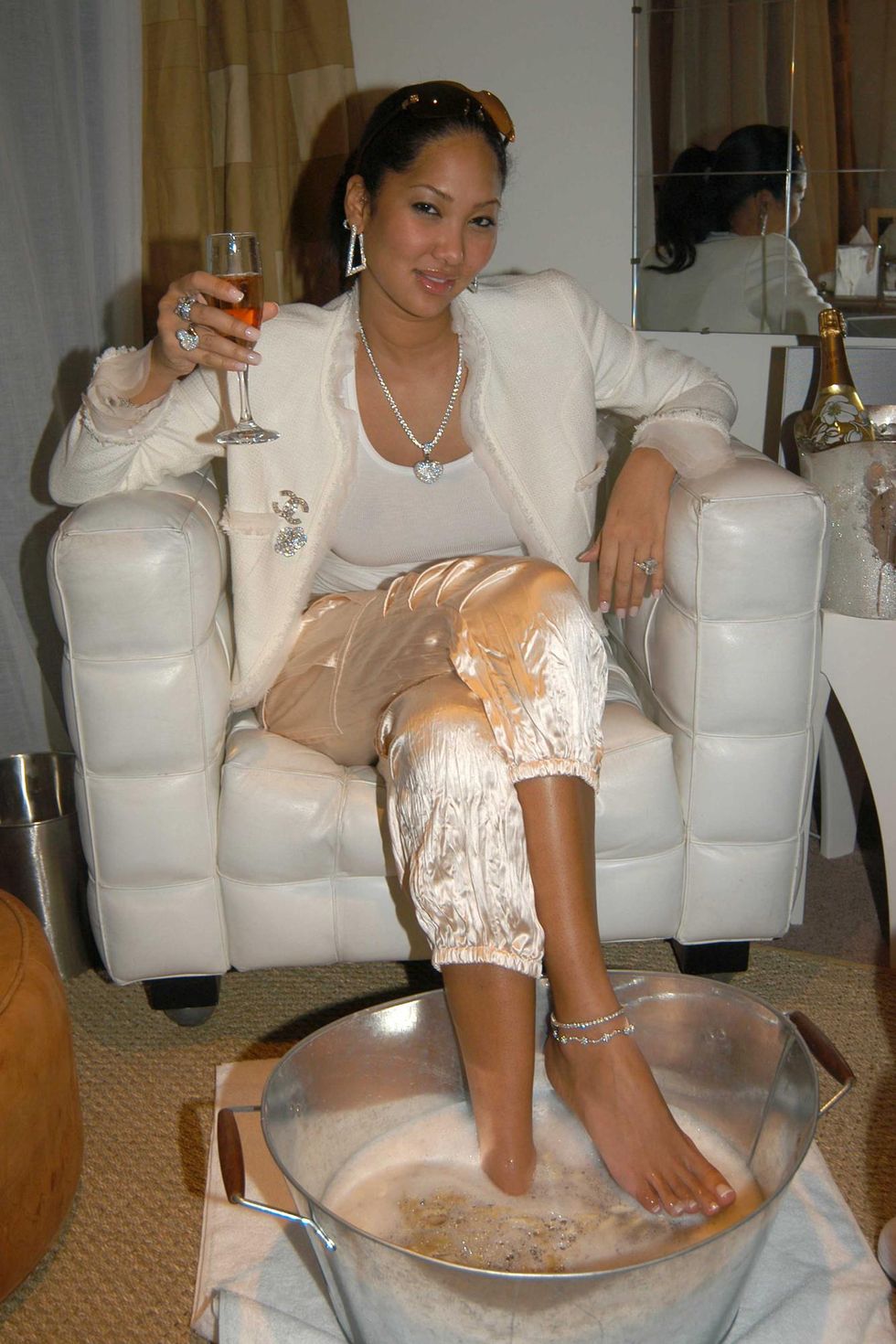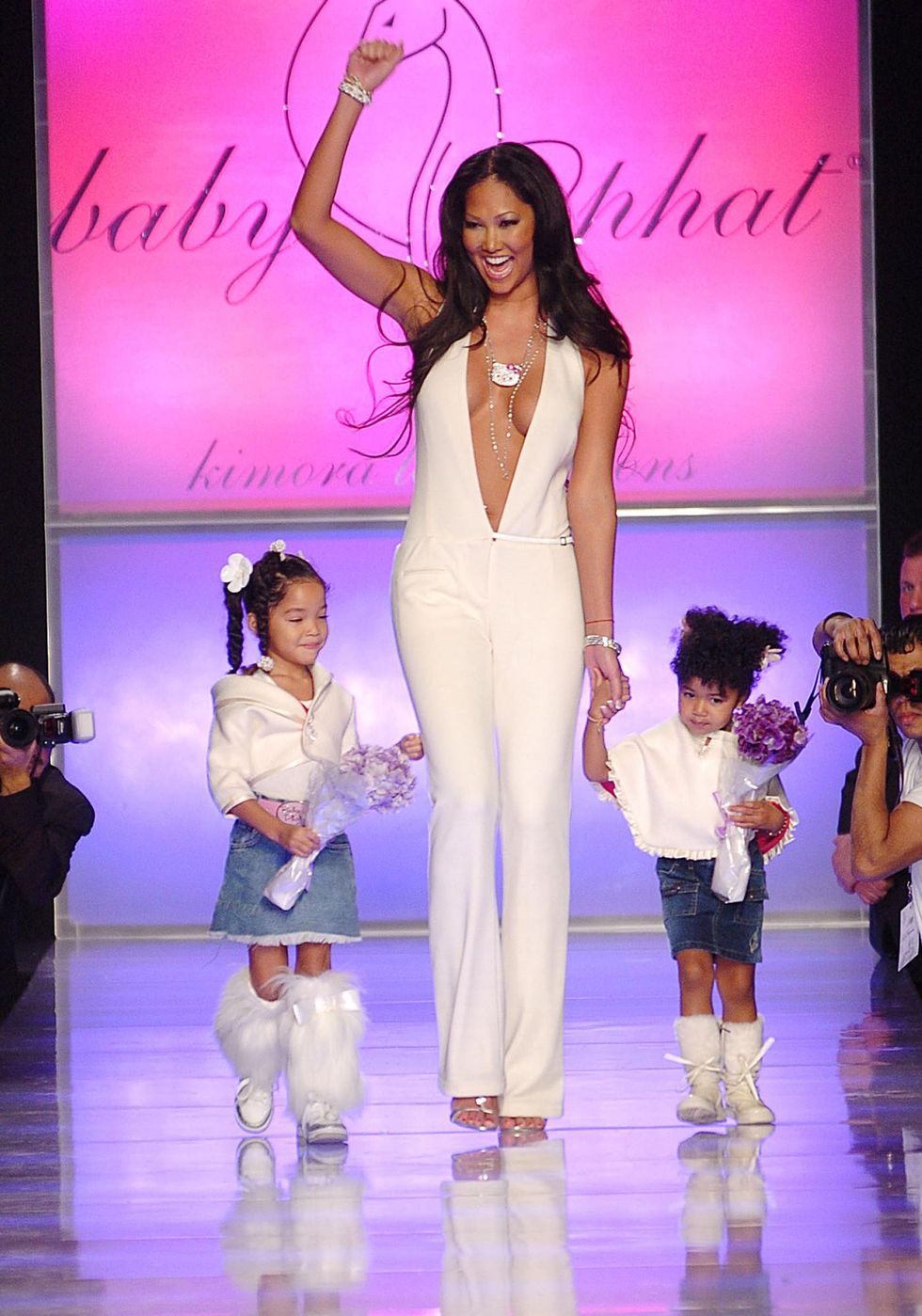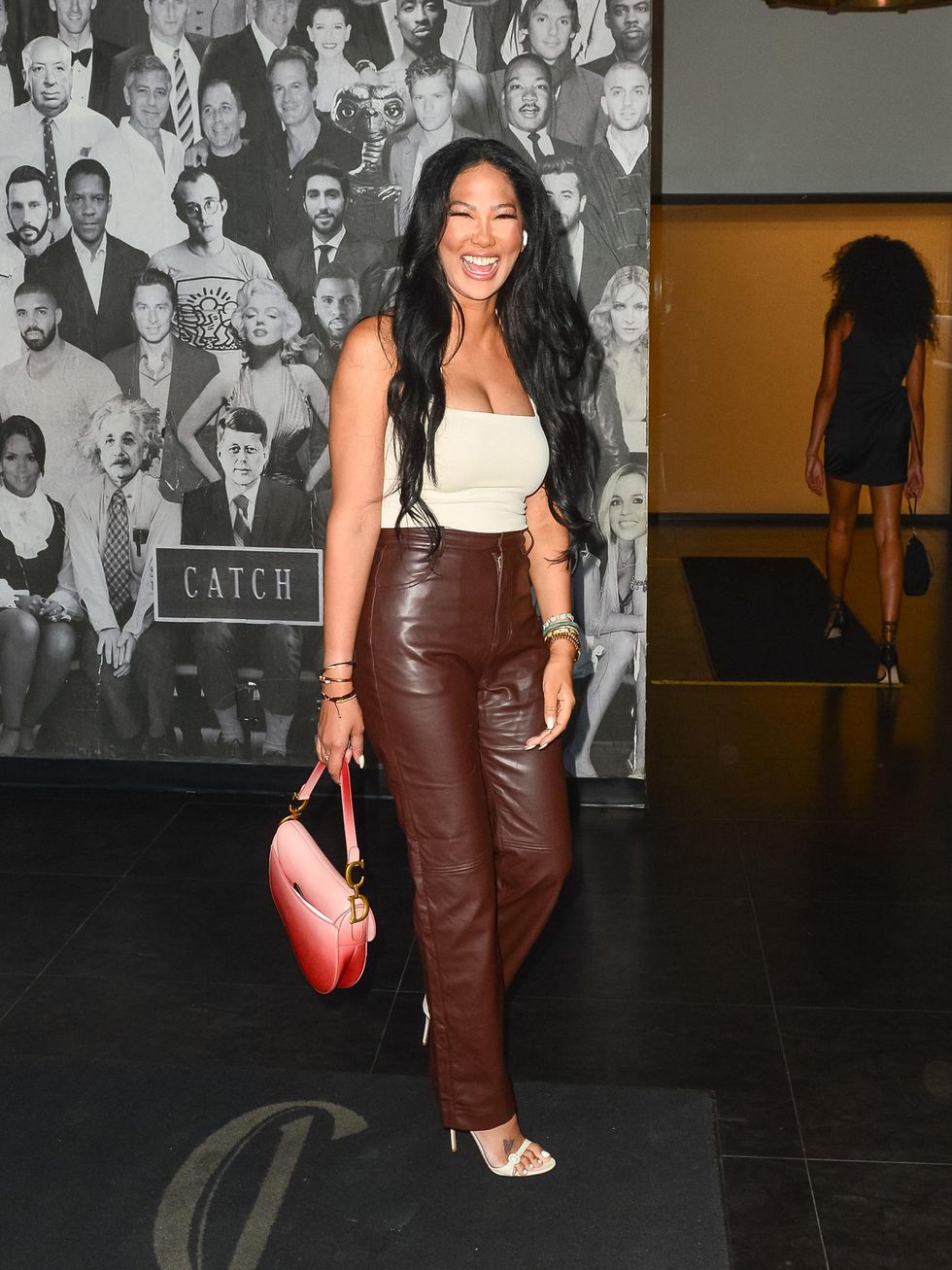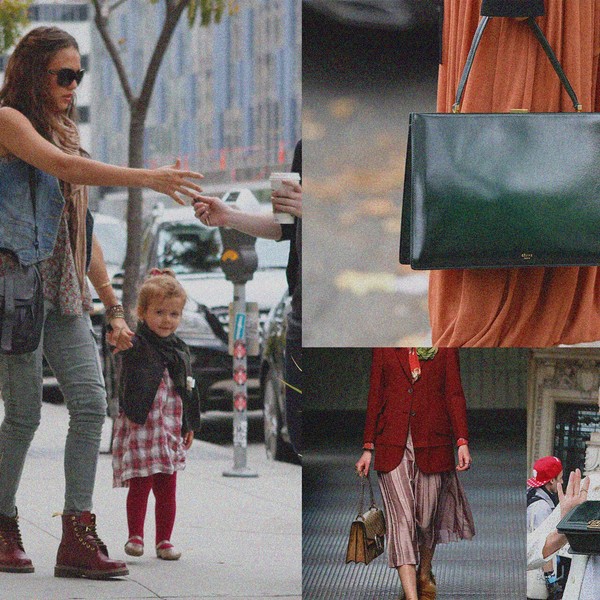We Have a Lot to Learn from Kimora Lee Simmons
Between Baby Phat and being babysat by Naomi Campbell, Lee Simmons redefined the American Dream.

A photo of Kimora Lee Simmons circa 2004 recently circulated on social media. In it, she wears a CHANEL jacket and designer sunglasses. Her fingers are adorned with diamonds, as are her ankles and ears, and a heart-shaped diamond pendant glints as she raises a glass of Cristal to the camera. Her feet bare, and soaking in a bucket of champagne. "Kimora Lee Simmons having a Champagne Pedicure," reads the picture's caption on Getty. You, too, can download the image...for $500.
Since she signed an exclusive contract with the house of CHANEL as a six-foot tall teen, the name Kimora Lee Simmons has become synonymous with excess. It's an identifier that's likely at odds with her own sense of self, which she articulates as "dorky Dorothy from Kansas." Throughout her career, Simmons' fish-out-of-water mentality stubbornly resisted her steadily padding resume. Even as she was babysat by Naomi Campbell, booked jobs with Dior, or founded a fashion brand beloved by the likes of Britney Spears, she was always just Kimora Lee: the girl from St. Louis.
Now, after buying back her soon-to-be relaunched brand Baby Phat, graduating business school, producing a Broadway show (she won a Tony), penning a critically-acclaimed life manual, showrunning a seven-season docu-series, Kimora Lee Simmons has once again merged into the fast lane and on her way to Oz. Below, the Missourian breaks down super-modeling, moguldom and motherhood—oh, and spoiler alert: she's earned the champagne showers.

Photo: Getty
Starting at the beginning here, but growing up multi-ethnic in 1980s Missouri must have been a very specific experience:
"Absolutely! I used to tell people Mariah Carey was an exotic mix when I was coming up. Nowadays the world is a melting pot, but back then I was at the forefront of that and in a landlocked area. I had to get out. I didn't realize this at the time, but my mom put me in modeling lessons to have more confidence and better posture—I was six feet tall, and wouldn't stand up straight. I felt like the ugliest duckling in the world. I took a variety of workshops and people said, 'If you want to give this modeling thing a go, you could.' I ended up at a modeling conference in the midwest and was discovered by Marilyn Gaultier agency, who took me to Paris."
At the time, was modeling synonymous with beauty from your perspective back then?
"Over time I felt beautiful, but then I just felt like a weird thing. I saw myself as a United Colors of Benetton campaign, I wasn't Cindy Crawford, the 'All-American girl' apple pie. Then when I got to Paris, and landed the gig in CHANEL, which was like a cabin girl. I tried on the clothes. That led me to the runway show and ultimately I was the 'bride,' which was the coveted position. And I was looked after by Karl and Naomi Campbell, and that was my start at 13."
When you say you were 'looked after,' what did that mean at the time?
"I was a dime-a-dozen coat-hanger, but because I was a child. The girls that we knew as 'super models' would be passing around a flask backstage and that flask would not come to me. Andre Leon Talley made sure that flask did not come to me. I was doing my homework everyday under the racks of clothes, I wore leggings and converse everyday because that's what I could afford. I washed my hair everyday, slicked my hair back into a chignon. And then it was Karl who said, 'Here's Naomi, she's here too without her mom, and you guys go off together.' She would've been in her late teens."
Were you aware of the magnitude of the job at the time? Were you under pressure to maintain your measurements?
"I don't think I got it. I saw girls who went through a lot. I've been in model apartments and seen girls eating baby food or putting orange juice on sponges and trying to get the sponge down to soak up their tummies. Chocolate chewable laxatives that would make their insides bleed. I've seen people do so much cocaine that they could put a kerchief up one side of their nose and it would come out the other side. That was never me, I've never been one for anything crazy like that. I have a fluttery heart, which is probably a good thing because I might have gone down that road. But I watched this shit tear people down. I feel like a survivor."

Photo: Getty
How did you not go down that road?
"I think because it was weird for me! I'm from the Midwest, I was eating burgers, fries and a milkshake. There was no one who was even 16 or 17, Naomi is the next oldest. I was a kid but I saw lots of stuff. It was a different time, fashion was rock'n'roll. There were top models, rockers."
There had been Gia and Janice, but it seems the explosion or genesis of the 'supermodel' wasn't until your era:
"I would say there was Linda and Cindy, Christie, Naomi who were the supermodels and me and everyone else was a top model. They would have been in their early 20s, I was just a baby."
How do you think that celebritization of the model impacted fashion?
"I think it's been a seismic shift. These were not just divas, they were timeless classics. It took something that was insider-y and became way more public. It made it a little bit less special, because suddenly there were so many more eyeballs on you."
Baby Phat is such a fascinating case study, because while everyone has worked out how to parlay their fame into a successful business now, it seemed very difficult for your generation of talent to break out of their lane:
"You couldn't break out of your mold. No one turned anything into anything else in terms of business. Very few made that jump into the business world, and to this day many of the classics have only started to at 50."

Photo: Getty
Where did you find the confidence?
"I think a lot of it came from fear. When it came to being a great mom and being gracious through a divorce or whatever else, it came from this fear to not raise assholes. The fear of not succeeding, or that my destiny was in the hands of someone else based on my beauty, that was weird to me. Like what if something happened and overnight you're not the 'hot' girl? You're going from being the weird girl to being thrust into a very hot spotlight. So back then the fear was maybe it all wouldn't be okay, so what was the next thing for me? Turning what I'd learned in fashion into something else."
Were you taken seriously at the time?
"Well since it was the female counterpart to Phat Farm, Russell's brand, who I married and had my girls with and then went on to divorce his ass, I had a voice in a room and a lot of experience. I floated in between fashion and hip hop and created a lifestyle that became a brand. It spoke to girls everywhere. Not everyone was born with a silver spoon in their mouth, so it resonated. There were no models that were really doing this, and it was like sink or swim. Then it became this crossover of major magazines, fashion, celebrities, badass women. I felt at the dawn of all these things."
How swift the celebrity embrace of the brand seemed so unique. You'd found this intersection of luxury and streetwear and there were so many A-list endorsement:
"Exactly! We came up at a time when we were beginning to celebrate ourselves. And we really were friends in a community of fashion. It certainly was [the inception] of what is cool today. But I remember Baby Phat dressed Madonna for her tour, Britney Spears, Destiny's Child. When Cam'ron had the pink fur he was carrying a Baby Phat phone. Everyone was supporting. We were the original hot girls!"
How much do you credit that to the designs, versus your cache and what you brought to the brand?
"It was totally what I brought to it, I think I can say that. I've had amazing design teams, but I put my blood, sweat, tears, it was authentic and a real vibe. They were my peers, I grew up amongst them. I curated a lifestyle that was the American dream, and what that meant for a girl like me. And I made it."

Photo: Getty
Now it must seem a whole lot easier to 'make it'—anyone can utilize their social capital to build a brand:
"'Easier' comes to mind, but so does 'careful.' There are pitfalls to popping off so quickly."
How were you navigating that immense success at the time? Did it feel like a lot to keep up with, or a lot to lose?
"There's always a mounting pressure when it comes to business, it becomes a lot to lose. It became a movement, and I was determined to become a mogul—as well as a mom and mogul. But now as a businesswoman and entrepreneur, turning tragedy into triumph, I was always at the forefront."
Is the resurgence of y2k surreal for you?
"We thought we were so edgy and hot with our low rise jeans and hips poking out. It doesn't surprise me that the girls are turning back to you the early 2000s for some color and flavor. Ming pulls out all these photos of me in these boots and says, 'Where are these, mom? You're holding out on me.'"
What's it like to raise girls in the digital age?
"It's been difficult to navigate. Things have become hypercritical. There's such an inflated sense of bullshit, and it's so easy to get out of hand. It's like, do you want to create a whole other persona and maintain that? That's a lot to live with. It's like focus on being the girl behind the scenes you want people to think you are fronting for the camera. I've always been grateful to just be myself and not have to keep up with a false version of myself."
How do you measure success now?
"I judge success in terms of impact and legacy. So when people tell me I've inspired them to get out of an abusive relationship, or start a business or be a single mom, to me, that is success. The more you realize your passion and are true to your authentic self, the more rewards will come—those riches will be yours."
Top photo: Courtesy of Instagram/@kimoraleesimmons
Want more stories like this?
Kimora Lee Simmons Is Making Fabulosity a Family Affair
Ciara's Life Secrets: '90s Jeans & Marital Respect When It Comes to TV
Meagan Good Is Unapologetically Owning Who She Is in 2021 & Beyond




